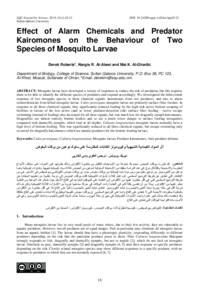وثيقة
Effect of alarm chemicals and predator kairomones on the behaviour of two species of mosquito larvae.
المعرف
DOI: 10.24200/squjs.vol24iss1pp18-22
المصدر
Sultan Qaboos University Journal for Scientific. v. 24, no. 1, p. 18-22.
المساهمون
Al-Alawiyah, Nargis R., مؤلف
Al-Gharibiyah, Mai K., مؤلف
عناوين أخرى
أثر المواد الكيميائية التنبيهية وكيرومونز الكائنات المفترسة على سلوك نوعين من يرقات البعوض.
الدولة
Oman.
مكان النشر
Muscat.
الناشر
College of Science, Sultan Qaboos University.
ميلادي
2019-05-21
اللغة
الأنجليزية
الملخص الإنجليزي
Mosquito larvae have developed a variety of responses to reduce the risk of predation, but this requires them to be able to identify the different species of predators and respond accordingly. We investigated the behavioural response of two mosquito species to three chemical signals: kairomones from two predators, and also to alarm semiochemicals from killed mosquito larvae. Culex perexiguus mosquito larvae are primarily surface filter-feeders. In response to all three chemical signals, they significantly reduced feeding by the high-risk active bottom scraping of biofilms in favour of the less active (and so lower predator-detection risk) surface filter feeding. Active escape swimming (instead of feeding) also increased for all three signals, but was much less for dragonfly nymph kairomones. Dragonflies are almost entirely bottom feeders and so are a much lower danger to surface feeding mosquitoes compared with damselfly nymphs, which feed at all depths. Culiseta longiareolata mosquito larvae normally have a high level of bottom-feeding. This was significantly reduced to all three chemical signals, but escape swimming only occurred for dragonfly kairomones (which are natural predators for the bottom-feeding larvae).
ISSN
2414-536X
الملخص العربي
طورت يرقات البعوض مجموعة متنوعة من الاستجابات لتقليل خطر الافتراس، لكن هذا يتطلب منها أن تكون قادرة على تحديد الأنواع المختلفة من الحيوانات المفترسة والاستجابة وفقًا لذلك. قمنا بدراسة الاستجابة السلوكية لنوعين من البعوض لثلاث إشارات كيميائية: الكيرومونات من اثنين من الحيوانات المفترسة، وكذلك لإنذار المواد الكيميائية شبه الكيميائية من يرقات البعوض المقتولة. يرقات البعوض Culex perexiguus هي في المقام الأول مغذيات سطحية. استجابة لجميع الإشارات الكيميائية الثلاثة، قاموا بتقليل التغذية بشكل كبير عن طريق كشط القاع النشط عالي الخطورة للأغشية الحيوية لصالح تغذية المرشح السطحي الأقل نشاطًا (وبالتالي انخفاض خطر اكتشاف الحيوانات المفترسة). زادت أيضًا السباحة النشطة للهروب (بدلاً من التغذية) لجميع الإشارات الثلاثة، ولكنها كانت أقل بكثير بالنسبة إلى حورية اليعسوب كيرومون. تتغذى اليعسوب بالكامل تقريبًا على القاع، وبالتالي فهي تشكل خطرًا أقل بكثير على البعوض الذي يتغذى على السطح مقارنة بالحوريات الدامسة، التي تتغذى في جميع الأعماق. عادةً ما تتمتع يرقات البعوض Culiseta longiareolata بمستوى عالٍ من التغذية في القاع. تم تقليل هذا بشكل كبير إلى جميع الإشارات الكيميائية الثلاثة، ولكن السباحة الهروبية حدثت فقط بالنسبة إلى اليعسوب كيرومونات (وهي مفترسات طبيعية ليرقات التغذية السفلية).
قالب العنصر
مقالات الدوريات

